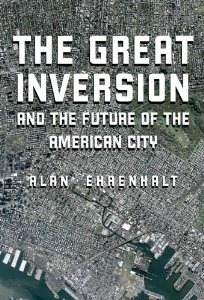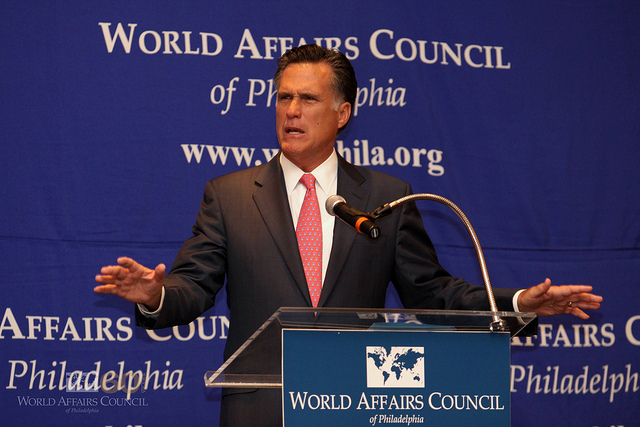 For nearly 20 years, Alan Ehrenhalt served as the executive editor of Governing magazine, examining and writing about a variety of local and state-level trends and policies. In his new book, The Great Inversion and the Future of the American City, Ehrenhalt outlines at length what he dubs “a major change in American urban life” over the last decade: namely, that “living patterns are rearranging all throughout a metropolitan area,” something he calls a “demographic inversion.”
For nearly 20 years, Alan Ehrenhalt served as the executive editor of Governing magazine, examining and writing about a variety of local and state-level trends and policies. In his new book, The Great Inversion and the Future of the American City, Ehrenhalt outlines at length what he dubs “a major change in American urban life” over the last decade: namely, that “living patterns are rearranging all throughout a metropolitan area,” something he calls a “demographic inversion.”
Ehrenhalt is no starry-eyed urban triumphalist (like Harvard economist Ed Glaeser), but nor is he predicting cities’ imminent demise (see Joel Kotkin). In fact, compared to the prophets of urban boom and doom, he’s a whole heap of downright boring nuance. Think of him as your teetotaling uncle at the family Christmas party — the one who doesn’t want the eggnog spiked.
But sometimes the sober, analytical observers offer insights you don’t get from the prognosticators — and if what Ehrenhalt says is true, there are big changes in store for both cities and suburbs. So we called him up to learn more.
 Q. Have you ever been on a riding lawnmower?
Q. Have you ever been on a riding lawnmower?
A. No. Have I missed much?
Q. No. You just kind of go back and forth in lines.
A. I’ve used almost every other kind of mower but not a riding mower. Not that sometimes I wouldn’t have minded sitting on a mower instead of pushing one.
Q. Well, the reason I ask is that we have this cultural ideal in this country — this image of having an acre or two that you can lord over. Do you really think Americans can learn to love city living again?
A. There are people like Joel Kotkin who are disappointed in cities because they lack the middle class population that he thinks cities should have. And therefore he is negative about the future prospects of cities. But the fact that young people, single people, couples, people with very small children want to live in cities is not a negligible event. The fact that people with four children and three cars and a gas grill don’t want to move out of the suburbs and into the cities doesn’t mean that something significant isn’t taking place.
Q. You call what’s happening here a demographic inversion, so it isn’t necessarily so much that we’re seeing on a wide scale a bunch of people flocking out of suburbs and back to cities.
A. A lot of people have gotten the mistaken impression that I’m predicting a mass movement of millions of people into the centers of cities. What we are seeing is a reversal in which the words “inner city,” which a generation ago connoted poverty and slums, [are going to mean] the home of wealthier people and people who have a choice about where they live, and the suburbs are going to be the home of immigrants and poorer people. And Census figures show that that’s taking place.
Q. It appears that my peer group — the millennial generation — is the main cohort moving back into cities.
A. I would say that’s right. There is a desire for urban life among the millennial generation, whether that’s life in the center of cities or life in town centers that are springing up in the suburbs. But some form of more walkable, urbanized living is part of the ethos of the emerging generation.
Q. With this inversion, aren’t we at risk of losing the racial and economic variety that attracts my generation to cities?
A. I think you’re going to have class segregation no matter what you do. It would be nice to have people of all classes living right next to each other in gentrified downtowns. That’s probably not going to happen. It is true that a gentrified area tends to become less diverse. Cities can’t solve all problems. They can certainly create affordable housing and cities have done that, but it’s a drop in the bucket.
Q. If poorer people are gradually moving to suburbs, does that mean that suburbs become the new slums? I don’t mean to be reductive, but doesn’t it cost much more to maintain suburban infrastructure — roads and transportation, for instance? Who pays for that?
A. I’ve never bought the argument that the suburbs were going to be slums, just that they would be ports of entry for people trying to make it into the middle class, rather than refuges for the affluent. It may be that with a lower tax base, some services would decline. But much of the infrastructure (parks, schools) is already in place.
Q. Do you see climate change affecting any of this? To make suburbs work in a carbon-constrained world, some major retooling is needed, but if the suburbs are increasingly the location of poor people, will anyone want to make the investment?
A. I don’t know much about this subject, but I don’t see global warming having a major effect on individual location choices unless it gets a lot worse than it is now.
Q. But the high cost of gasoline is something you do discuss in your book. What makes gas prices a factor now?
A. I’m not an expert at all in energy, but my amateur perception is that the average citizen feels that this spike in gas prices is not one that’s easily going to go away. We’re talking about what seems to me a demand-driven increase in the price of oil and the demand is coming from countries such as India and China, and I don’t see how that’s going to change. So it seems to me that we’re going to be living with high gasoline prices for the foreseeable future.
Q. Demographic inversion has big implications for cities and metro areas. What should government leaders or community activists do to prepare for it?
A. If the question is what should they do to encourage demographic inversion, then the answers are to promote mixed-use zoning, spend money on transit and policing, make sure there are parks for young children to play in, and support neighborhood schools. If you’re asking what they should do to ward off demographic inversion and create more diversity, I would argue that there isn’t much they can or should do. It’s very hard for governments to dictate settlement patterns. Segregation by class is a fact of American life.
Q. You grew up in Chicago, but now live in Clarendon, Va., which is like urbanized suburbia. What made you settle in Clarendon versus D.C. proper?
A. To be honest, my wife and I did live in D.C. for a while when we were first married, and then we moved to Virginia because her parents were out there. It really wasn’t much more complicated than that.



